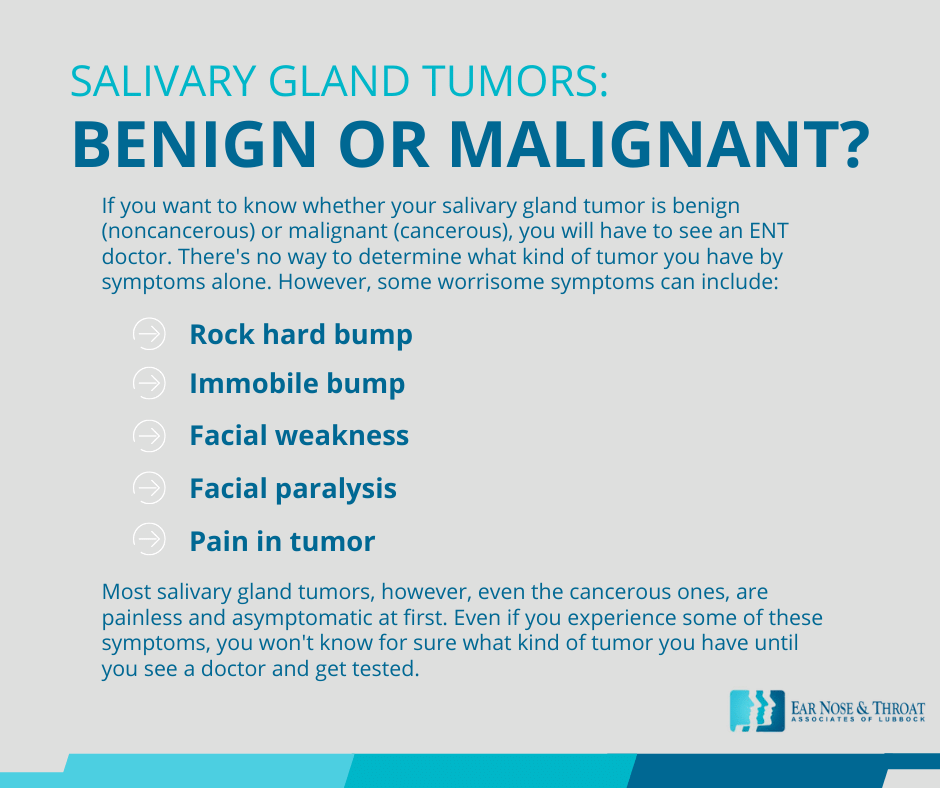Salivary Gland Tumors: Everything You Need To Know

Salivary gland tumors are usually diagnosed in one of two ways. Either you notice a strange bump in front of your ear, or a doctor feels that bump during a routine medical appointment.
A bump is often the first and only symptom of a salivary gland tumor.
Salivary gland tumors are not common. Each year, for every 100,000 people only about five will develop a benign salivary gland tumor, and only one will develop a malignant tumor.
But what causes salivary gland tumors? And how do you treat a salivary gland tumor if you’re one of the unlucky few who gets one?
What Are Salivary Gland Tumors?
Salivary glands are responsible for producing the saliva that moistens our mouths, begins to break down our food, and keeps our oral tissues healthy.
We all have two types of salivary glands: major salivary glands and minor salivary glands. Minor salivary glands are tiny, numerous, and scattered throughout the mouth. A tumor in these minor glands is almost unheard of. We also have three pairs of major salivary glands:
- Parotid glands in front of the ears.
- Submandibular glands just below the border of the jaw.
- Sublingual glands below the tongue.
Tumors can occur in these major glands. The vast majority — about 80% — of salivary gland tumors grow in the parotid gland.
Salivary gland tumors grow slowly and can range greatly in size. Very small tumors may go unnoticed since they don’t usually produce any symptoms. When they reach one centimeter, patients may be able to feel a bump when they touch the area. At two centimeters and above, the tumors become big enough for patients to notice visually.
The cause of salivary gland tumors remains somewhat of a medical mystery. One type of salivary gland tumor, the Warthin tumor, has been linked to smoking, but in general researchers haven’t found a link between salivary gland tumors and lifestyle choices, genetics, or other clear causes.

Salivary Gland Tumors: Benign or Malignant?
If you want to know whether your salivary gland tumor is benign (noncancerous) or malignant (cancerous), you will have to see an ENT doctor. There’s no way to determine what kind of tumor you have by symptoms alone. However, some worrisome symptoms can include:
- Rock hard bump.
- Immobile bump.
- Facial weakness.
- Facial paralysis.
- Pain in tumor.
Most salivary gland tumors, however, even the cancerous ones, are painless and asymptomatic at first. Even if you experience some of these symptoms, you won’t know for sure what kind of tumor you have until you see a doctor and get tested.
About 75% of salivary gland tumors in the parotid gland are benign. About half of submandibular tumors are benign. Sublingual gland tumors are very rare, but most are malignant.
To diagnose a salivary gland tumor and determine whether it is cancerous, your ENT doctor will order a CT scan and a fine needle aspiration biopsy.
The biopsy sample will go to a laboratory to be examined under a microscope. This will reveal whether your tumor is benign or malignant. It can also show exactly what type of benign or malignant tumor you’re dealing with, which will help your surgeon determine the best next steps.
Treatment for Salivary Gland Tumors
Treatment for salivary gland tumors generally involves the surgical removal of all or part of the affected salivary gland.
For example, a superficial parotidectomy removes the 85% of the parotid gland that sits on top of (superficial to) the facial nerve, but not the 15% that sits below the facial nerve. Surgery to remove the entire gland is called a total parotidectomy.
If a salivary gland tumor is malignant, patients may require radiation therapy as well. Malignant parotid tumors, specifically, tend to be less aggressive than typical cancerous tumors. This doesn’t mean they’re not dangerous, only that they’re slower to grow and spread.
Discovering a salivary gland tumor is benign doesn’t mean it won’t need treatment. The most common type of noncancerous tumor, the pleomorphic adenoma, can actually become cancerous if it goes untreated for too long. In fact, benign parotid tumors can be more aggressive (faster growing) than other types of benign tumors in the body.
The good news is that most parotid tumors are diagnosed fairly early because of their obvious appearance.
Outlook After Treatment for Salivary Gland Tumors
The outlook for patients diagnosed with salivary gland tumors is excellent in most cases.
It’s extremely rare for salivary gland tumors to be both aggressive and malignant, which is good news. It means people often have the time to notice a lump in their salivary gland and get it checked out before a cancerous tumor has the chance to spread.
The key is to catch salivary gland tumors in a timely manner and treat them appropriately right away. Fortunately, their high visibility makes early treatment more likely.
Do You Suspect You Have a Salivary Gland Tumor?
The surgeons at ENT Associates of Lubbock are experienced in the identification and treatment of salivary gland tumors. Although these tumors are rare, it’s important to catch them early so they can be addressed effectively.
If you’ve found a lump in one of your salivary glands, give us a call today to schedule an appointment.
Dr. Scolaro is a board-certified Otolaryngologist servicing the South Plains area. He has been practicing in Lubbock since 1990 and has earned a reputation as a skilled and experienced surgeon. He currently serves as the Medical Director for Covenant High Plains Surgery Center campuses, is a member of Covenant Health Partners and is an adjunct faculty professor for Texas Tech University Health Sciences Center School of Medicine. Learn more about Dr. Scolaro.
Categories:








